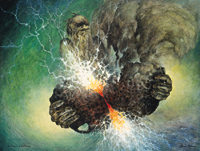


Australian Meteorology through the 20th Century
Introduction
The Origins of Australian Meteorology
In the Beginning
Australia's Meteorological Pioneers
The Lead-up to Federation
Meteorology in the 20th Century
The Weather and Climate of the Twentieth Century
The Great Weather and Climate Events of the Twentieth Century
A Century of Progress in Science and Service
References
Australian Meteorological Milestones of the 20th Century
Endnotes
Index
Search
Help
Contact us

Meteorology, along with astronomy, is one of the oldest sciences we have. Although the systematic study of Australia's weather and climate began with the arrival of the First Fleet in January 1788, the origins of Australian meteorology go back long before the time of European settlement to the observations, belief systems and lifestyle of the Aborigines who, over a period of 40,000 years or more, had witnessed the retreat of the last ice age and learned to live with the rhythm of the seasons and the extremes of weather and climate.
In the Beginning
All the weather and climate phenomena we know today played a part in the lives of the early inhabitants of the Australian continent. But in different parts of Australia there were different names and different explanations for the various atmospheric forces—thunder, lightning, rainbows, clouds and winds—and the march of the seasons. The peoples of Arnhem Land defined the seasons in terms of the 'balmarrk wana' or 'big winds' with the wet season brought on by barra the northwest monsoon (Jones and Meehan 1997). The Aboriginal people of central Australia developed a very different understanding of the seasons, and their influence on the land and its animals and plants. Further south in Tasmania, they had learned to recognise the signs of changing weather and to make use of fire for protection against the cold.Much of the modern understanding of the Aboriginal interpretation of weather and climate in various parts of Australia has been captured in a series of writings and paintings by anthropologist Charles P. Mountford, and artist Ainslie Roberts (Figure 1).

 |
Bureau of Meteorology |  |
© Online Edition Australian Science and Technology Heritage Centre and Bureau of Meteorology 2001
Published by Australian Science and Technology Heritage Centre, using the Web Academic Resource Publisher
http://www.austehc.unimelb.edu.au/fam/1597.html